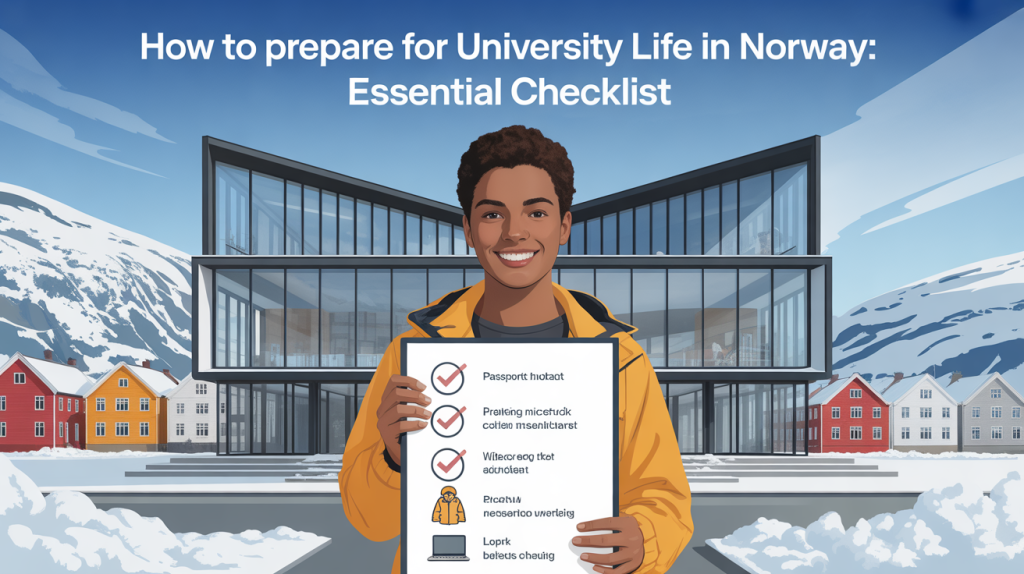How to Prepare for University Life in Norway: An International Student’s Checklist
Admission and Documentation: The First Step to Success
The foundation of your Norwegian university journey begins with obtaining an official offer of admission. This document is critical—not only as proof of acceptance but also as a prerequisite for visa and residence permit applications.
Key Actions:
- Secure your admission offer: Make sure your letter of acceptance is official and contains all required program details.
- Verify document requirements: Each university may have unique documentation demands; ensure you have transcripts, diplomas, and language certifications ready.
For education recruitment teams, prompt issuance and clear communication of admission letters improve applicant confidence and reduce processing delays.
Visa and Residence Permit: Navigating Regulatory Requirements
For students outside the EU/EEA area, acquiring a student residence permit is mandatory to live and study in Norway legally.
Essential Visa Application Checklist:
- Admission letter from the Norwegian institution.
- Proof of sufficient funds to cover living expenses during your stay.
- Evidence of tuition fee payment, if applicable.
- Additional documentation as outlined by Norwegian authorities.
Submit these materials well in advance to avoid processing delays and ensure permit approval before semester commencement.
Tips for Recruiters & Admissions Offices:
- Provide candidates with detailed visa application guides.
- Offer early reminders about critical deadlines.
- Establish partnerships to streamline document verification.
Financial Preparation: Ensuring Stability and Compliance
Financial documentation is a vital aspect of the permit application and a determinant of student well-being during university life. Norwegian authorities require proof that students can cover their living costs, typically through bank statements or sponsorship letters.
Critical Financial Preparation Steps:
- Prepare formal evidence of financial resources as per current Norwegian immigration standards.
- For non-EU/EEA and Swiss students, ensure tuition fees are paid prior to visa submission when applicable.
Housing Arrangements: Securing Your Home Away from Home
Housing in Norway is often managed by student welfare organizations closely affiliated with universities.
Housing Preparation Checklist:
- Apply for student accommodation immediately after admission.
- Use pre-booking codes often provided by your institution to apply through welfare organizations.
- Notify housing providers of any accessibility needs or special requirements.
- For non-EU/EEA students, applications submitted within deadlines usually guarantee accommodation.
Travel Planning: Arrive Prepared and On Time
Timely arrival is critical to attend orientation sessions and start classes promptly.
Travel Essentials:
- Arrange flights and local transportation well ahead of semester start.
- Compile and carry all necessary documentation: passport, admission letter, residence permit, and housing confirmation.
- Familiarize yourself with Norway’s climate and local customs to ease cultural adjustment.
University Registration and Semester Start: Activate Your Student Journey
Upon arrival, students must complete registration formalities to activate their student status and access campus services.
Registration Steps:
- Pay semester fees and register officially at the university.
- Create a student user account to access academic portals, course materials, and communication tools.
- Obtain a physical student card to benefit from campus facilities such as libraries and laboratories.
- Enroll in courses and exams via the university’s digital platforms.
Part-Time Work and Rights: Balancing Study and Employment
International students holding a Norwegian student residence permit are permitted part-time work to supplement income, subject to certain rules.
Work Regulations:
- Work up to 20 hours per week during the academic semester.
- Full-time work allowed during holidays.
- Understand restrictions on self-employment and work permits.
Before Arrival: Practical Checklist for International Students
To ensure a smooth transition, students should complete the following practical steps before leaving for Norway:
- Secure health insurance if required by the university or Norwegian authorities.
- Learn about Norwegian customs, student welfare services, and campus life norms.
- Review university-specific checklists and attend mandatory orientation sessions.
Summary: Your Comprehensive International Student Checklist for Norway
| Step | Action Item |
|---|---|
| Admission | Receive and confirm official offer of admission |
| Visa | Apply for and obtain student residence permit |
| Financial | Prepare proof of finances; pay tuition fees |
| Housing | Apply promptly for student accommodation |
| Travel | Arrange transport; pack all required documents |
| Registration | Register for semester; create student accounts |
| Course Enrollment | Sign up for courses and exams |
| Work Rights | Understand part-time employment rules |
| Pre-Arrival Preparation | Secure insurance; familiarize with local culture |
How Study in Norway Supports International Students and Institutions
At Study in Norway, we specialize in education marketing, international student recruitment, and tailored solutions for Norwegian higher education institutions. Our deep expertise allows us to provide:
- Streamlined communication workflows to facilitate admission and visa processes.
- Digital tools to help students complete housing and registration seamlessly.
- Targeted marketing campaigns that reach prospects globally.
- Data-driven insights to optimize recruitment and onboarding cycles.
Our comprehensive platform empowers universities, recruitment agencies, and HR teams to deliver integrated student experiences—maximizing satisfaction and retention.
Take the Next Step with Study in Norway
Embark on the journey with confidence – prepare thoroughly and partner with Study in Norway to unlock the full potential of international education opportunities.

